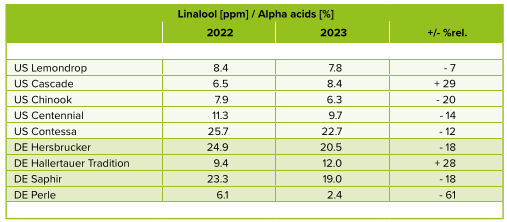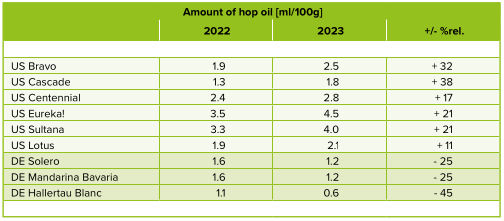* Market outlook
* Oil check
* Weather updates
* Hop profile: Simcoe
* Additional reading
Welcome to Vol. 7, No. 10. First, if you are reading this, then the transition to EmailOctupus is a success. The newsletter itself may look a little different the next few issues as I learn my way around the software. Second, Best of Craft Beer Awards has signed up to sponsor Hop Queries, helping subsidize getting this in your emailbox. I appreciate that and would welcome another sponsor.
Third, if you wish to contribute as well, you may do that here. What does not go to EmailOctupus will be used to find information hiding behind paywalls. Finally, I have given Hop Queries their own website, to house the archives and occasionally provide new information. Among other additions, I have included a list of resources. Feel free to suggest additions.
WE’LL KNOW MORE IN JUNE . . . OR LATER
My story about why farmers in the Northwest are ready to remove 10,000 acres (about 18 percent of what was harvested last year) from production in 2024 has posted at Brewing Industry Guide (subscription required). Short term, this means there are plenty of hops out there, often at bargain prices.
Long term, think about how many times you have seen the term “soft landing” used when discussing the American economy. How does that usually work out? The market for hops has always been cyclical and landings have not often been soft. It will be a year or more before it is clear if this year is different. I posted a chart at AppellationBeer.com that shows craft beer production the past 10 years. It went up, it went down, it changed, but after eight years is basically unchanged. However, craft beer certainly changed.
Should farmers harvest 10,000 fewer acres in 2024, the total will be quite close to 2015. What is on the acres will be much different. Decisions about that are being made right now. There will be numbers to look at in June, when the USDA reports what is strung for harvest. I will report back.
CHECK THE OIL PLEASE 1
As it does after each harvest, Hopsteiner has analyzed the average oil composition of several varieties. The top chart compares the ratio of linalool to alpha acids, providing a way to assess aroma intensity of hops added late in the boil, or at the end. For instance, Chinook could be expected to add less aroma, compared to 2022, when the same dosage is added. (DE refers to hops grown in Germany and US to hops grown in the United States.)

The second chart shows the total oil content of varieties often used for late and dry hopping. You will notice that a) US-grown varieties generally contain higher amounts of essential oil, b) that those were much higher in 2023 than 2022, and c) German total oil was significantly lower, particularly Hallertau Blanc.

Of course, these are only a few of the choices brewers have. Consider the charts reminder of the importance of checking the COA before making hop additions. Not only because of year-to-year variations, but also lot-to-lot differences.
WEATHER UPDATES
– Brent McGlashen at Mac Hops in New Zealand posted these photos (some videos) on Instagram with a report about how hot and dry the 2023-2024 growing season has been.
“Well, it sure is dry! Growing season 2023/24 will go down as the driest on record for our Moutere Farm. No recharging heavy rains and the constant heat has meant the available water has trended only down. We have heavy water restrictions on one of our blocks, but still have our dams in the hills for the rest of our other blocks there. Plant health is paramount in these times and we are beyond impressed with how this block is carrying on not even looking bothered. Sure has taken lots of management and fine tuning, but it shows how capable these plants are. In fact, we are quite excited to see what additional aromas and complexities we may be able to extract out of this season’s crop from this block.”
– From Washington, CLS Farms reports that growers are concerned about below average snowfall. This Instagram post includes a map showing current water levels in reservoirs.
“We’ve had a pretty mild winter despite some heavy snowstorms that came through in January. This year, we’re experiencing an El Niño, which means the PNW experiences higher than average temperatures and less snowfall while the southern parts of the USA experience greater precipitation.
“Hops need ample water and sunlight to grow strong. Right now, reservoirs in WA sit at 55% to 75% of average or ‘normal’ levels. This makes it challenging for growers who rely on reservoirs for irrigation. Not all hope is lost, though. Some growers have fields with wells or can work with neighboring landowners to share water.
“And some varieties can withstand less water than others. Newly bred varieties like Vista have a tolerance for low water similar to hops bred with neomexicanus hops that are used to growing in consistent drought conditions, like Lotus, Sabro, and Talus.
“What does this mean? The outlook as of February shows that growers will have a challenge accessing all the water needed, though if new or different storms occur, this could change”
HOP PROFILE: SIMCOE
Simcoe was well received when it was introduced in 2000, but by 2006 enough unsold inventory had built up growers almost gave up on it. “The demand just wasn’t there,” said Jason Perault, CEO and head hop breeder for Yakima Chief Ranches.
The attention beers such at Pliny the Elder and Weyerbacher Double Simcoe IPA attracted helped sustain it until larger brewers put in substantial orders. Production of Simcoe grew from 226,000 pounds in 2008 to 1.6 million by 2012 and peaked at almost 8 million pounds in 2017.
Heritage: When YCR 14 (which would be named Simcoe) was patented in 1999, she was described as “a new hop plant variety of unknown parentage which was discovered among plants created as part of a controlled breeding program.” Perrault was in high school in 1988 when he helped Chuck Zimmerman cross-pollinate several males and females of interest. “His feeling was it biased things talking about pedigree,” Perrault said. Zimmerman, who previously ran the USDA research facility at Prosser Station, kept a nursery at his house. “Warrior and Simcoe came out of those crosses. Simcoe was in row 2, hill 56. I still remember that. It had a nice-looking growth in the field.”
The patent described YCR14 as moderately tolerant to powdery mildew and stated that she would yield 2,650 to 2,800 pounds per acre. However, it turns out Simcoe is susceptible to powdery mildew and does not yield nearly that well. With Simcoe’s future uncertain, Perrault crossed her with a Nugget-derived male bred for resistance to powdery mildew. Some of the resulting seedlings had Simcoe’s unique aroma attributes, plus others of their own. One numbered HBC 369 turned out to be disease resistant with a much better yield. That one earned a name—Mosaic.
The basics: 10-16% alpha acids, 3.5-5.5% beta acids, .5-3 mL/100 grams total oil. Contains a significant level of 4MMP.
Aroma qualities: Known for her complexity, delivering berry notes, plums, passion fruit, pineapple and grapefruit.
ADDITIONAL READING
– Two magazines—Hopfen, from the German Hop Growers, and 2023 Czech Hops—are available to download.
– Upper Austrian Hops. Accusations of price fixing and other skullduggery in the 19th century. I also learned that these days Austrian farmers grow Comet and Sorachi Ace.
– What’s the difference between Old World and New World hops? I use the terms all the time, including in writing hop profiles, but I have begun to wonder if I should. More on that next month.
– The ultimate hop substitution list. From Hop Alliance in Michigan. It is extensive—including many varieties you won’t find on the IHGC list of international hop varieties—and Brian Tennis obviously put a lot of work into it. However, although I know why lists like this exist, I am hesitant to embrace recommending substitutes.
In recent conversations, Jim Solberg at Indie Hops and Darren Gamache at Virgil Gamache Farms both used the phrase “buckets of flavor.” I like the idea. Think about the aromas and flavors that the hop you want to replace produces. Consider the compounds that contribute that make the hop unique. Look for them in other cultivars. See Table 2 here.
1 If you remember full service gas stations, this subhead makes more sense.
I agree with you Stan. One of the many problems with these random Hops Substitution lists is that if you start following the possible graph paths through nodes and edges, then it turns out that every hops can be substituted with any other. You start f.i. with El Dorado = Bitter Gold = Nugget = Chinook = Amarillo = Azacca = Idaho7 = Citra = Columbus = Magnum = Pacific Gem = Belma = Huell Melon …….. We have worldwide far too many varieties with over 320 + and counting for barely 65.000 ha.
Great to hear from you Carlos. And well put.
Will I see you at the Craft Brewers Conference?